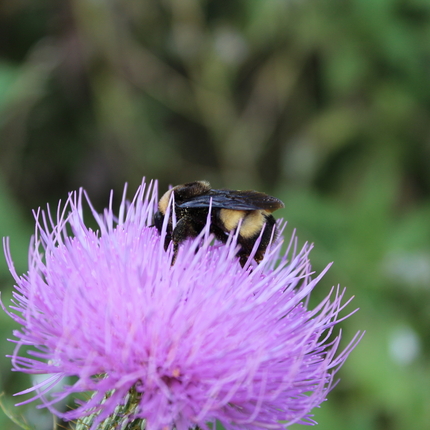Katie Lamke, Xerces Society, contributed to this blog.
Bumble bees are a charismatic and easily recognizable pollinator thanks to their loud buzz, fuzzy appearance, and distinct color patterns.
Throughout the U.S. and Canada, nearly 50 different species of bumble bees play an important role in sustaining the health of our environment. Bumble bees provide pollination services that contribute to a successful harvest of many crops and help to maintain diverse plant communities, including rangelands.
Unfortunately, many of North America’s bumble bees are experiencing dramatic population declines and face an uncertain future. While these declines are not fully understood, contributing factors include habitat loss, pesticide use, climate change, low genetic diversity, and the introduction and distribution of pathogens through commercial pollinators.
Some of the most immediate and productive steps to confront bumble bee declines are to (1) protect, restore, and manage habitat in a way that supports bumble bees, and (2) participate in a community science project that focuses on bumble bee conservation.
One such effort is the Nebraska Bumble Bee Atlas. Coordinated by the Xerces Society and the University of Nebraska-Lincoln, the Nebraska Bumble Bee Atlas involves people from all over the state who volunteer their time to contribute to scientific research.
Bumble Bee Atlas volunteers conduct surveys independently and submit their findings. Scientists then use that information to improve the ways we conserve bumble bees. For example, the Xerces Society will use the information to develop Nebraska-specific management recommendations and plant lists to serve as guidance for land managers who want to support bumble bees.
The Atlas provides online educational workshops that teach the ins and outs of bumble bee biology, how to identify Nebraska species, and the skills needed to conduct surveys, including how to net and photograph bumble bees. Trained volunteers then conduct at least two surveys in an area of their choosing between June and September. Volunteers have the opportunity to connect with other volunteers and Atlas experts if they need help getting accustomed to this new endeavor. Prior to receiving training, the only prerequisites are a sense of adventure and willingness to learn and contribute to the natural and made environments that support us.
For the upcoming 2021 season, the Atlas is seeking more volunteers in central and western Nebraska to better understand the distribution of bee species and the plants they utilize during the growing season.
Erin Schoenberg, project associate with the Center for Rural Affairs, participated as a volunteer for the Atlas in 2020, and is looking forward to another season of surveys in 2021.
“I was able to adopt a grid cell in the Sandhills and enjoy a much-needed weekend in nature during a year that otherwise saw very little travel,” she said. “An experienced family member helped me get the hang of netting bumble bees, and it was equally rewarding to complete the habitat survey that goes along with each bee survey. It gave me the chance to acutely observe the plants in the area, note evidence of wildlife and livestock, pay more attention to wind and weather, and rekindle my wonder of nature.”
You may be a landowner who has stayed rooted in a rural area all your life. You may be a small town dweller or urban resident. Wherever you’re from, you, too, are likely to learn a great deal about plant-animal relationships and human-nature relationships by participating in community science projects such as the Bumble Bee Atlas. The more you are aware of, take a role in, and enjoy doing, the more steps you are willing to take to remain informed and strengthen your stewardship of our resources.
To learn more about this community science project and how to get involved, visit Nebraska Bumble Bee Atlas. If you are not in Nebraska, Xerces Society and collaborators also run Bumble Bee Watch (U.S. and Canada), the California Bumble Bee Atlas, the Missouri Bumble Bee Atlas, and the Pacific Northwest Bumble Bee Atlas (Idaho, Oregon, and Washington).





